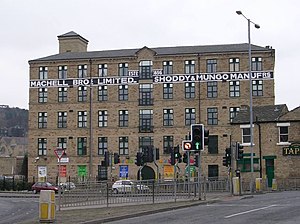
The Heavy Woollen District is a region of textile-focused industrial development in West Yorkshire, England. It acquired the name because of the heavyweight cloth manufactured there from the early 19th century.[1][unreliable source?][2]
The district is made up of parts of the modern day boroughs of Kirklees, Leeds and Wakefield in West Yorkshire, England.[3] Located around the towns of Dewsbury,[4] Batley,[5] Heckmondwike and Ossett,[6] the area extends to the towns and villages of Liversedge, Gomersal, Gildersome, Birkenshaw, Mirfield, Cleckheaton, Morley, Tingley, East Ardsley, Birstall and Horbury. The manufacture of wool cloth for clothing, blankets, rope and twine continues in the district.
The area was one of the key textile centres in Yorkshire, famed for its production of shoddy and mungo.[7][page needed][8] For years companies had tried to blend different fibres without success leading to the term, "munt go", i.e. "mustn't go" as a Yorkshire colloquialism. Machinery invented in Batley to grind soft rags (shoddy) is thought to have first been devised in 1813,[9] and for hard rags (mungo) later on. Most mills have either closed or put to other uses, but some shoddy/mungo mills remain such as Edward Clay & Son Ltd. in Ossett.

History
[edit]The Heavy Woollen District branch of the General Union of Textile Workers was formed in 1892 to service the needs of the local population. The union produced a publication entitled Heavy Woollen District Textile Record, as a newsletter for distribution to members by the union's local collectors of subscriptions.[10]
A contingent from churches within the Roman Catholic Diocese of Leeds visited cemeteries in France [when?] where the remains of 25 fallen soldiers from the Heavy Woollen District during World War I and World War II are interred.[11] Dewsbury Cemetery has a memorial dedicated to four soldiers who died at the Heavy Woollen District Military Hospital, Staincliffe, Dewsbury, from injuries sustained during WW1.[12][13]
Transport
[edit]The area was served by the Yorkshire (Woollen District) Electric Tramways between 1903 and 1934, which were replaced with buses operated by Yorkshire Woollen District Transport company.
Sport
[edit]There is still a Heavy Woollen District football association and junior cricket association,[14][15] both with representative teams. The cricket league originally defined the district as within a six-mile radius of Batley Town Hall, but this was extended to an eighteen-mile radius. The 'Heavy Woollen District Cricket Challenge Cup' was first competed for in 1883.[16]
See also
[edit]References
[edit]- ^ "Heavy Woollen District". The Dewsbury Partnership. Retrieved 28 March 2021.
- ^ "Wealth of war for boom mills". Dewsbury Reporter. 3 January 2008. Archived from the original on 1 July 2016. Archived from the original on 1 July 2016. Retrieved 4 April 2021
- ^ Nostalgia on Tuesday: Rise of the tram The Yorkshire Post, 13 June 2017. "...to feed the heavy woollen districts of Thornhill, Ravensthorpe, Heckmondwike, Batley, Liversedge, Hightown, Moorend and Birkenshaw." Retrieved 29 March 2021
- ^ "About Us Page". henryday.co.uk. Henry Day & sons, Dewsbury. Retrieved 6 April 2021.
- ^ Chisholm, Hugh, ed. (1911). . Encyclopædia Britannica. Vol. 8 (11th ed.). Cambridge University Press. p. 521.
- ^ Tattersfield 1909, p. 414.
- ^ Shell 2020.
- ^ Chisholm, Hugh, ed. (1911). . Encyclopædia Britannica. Vol. 8 (11th ed.). Cambridge University Press. p. 1054.
- ^ Shell 2020, pp. 26–27.
- ^ Turner, Ben. Heavy Woollen District Textile Workers Union, 1917. A short account of the rise and progress of the Heavy Woollen District branch of the General Union of Textile Workers. p.18, p.76, p.79 Printed by the Yorkshire Factory Times. via Huddersfield Exposed Retrieved 4 April 2021
- ^ Heavy Woollen War Cemeteries Pilgrimage Roman Catholic Diocese of Leeds, year of publication not stated, retrieved 4 April 2021
- ^ Memorial, Heavy Woollen District Military Hospital War Memorials Register, Imperial War Museums. Retrieved 4 April 2021
- ^ Names on Memorial War Memorials Register, Imperial War Museums. Retrieved 4 April 2021
- ^ Bleakley, John (29 April 2013). "HWDFA U17 Representative Football". Pitchero.com. Archived from the original on 29 November 2014. Retrieved 31 July 2014.
- ^ Heavy Woollen District Junior Cricket League
- ^ "History of the Heavy Woollen". Heavy Woollen District Junior Cricket League. Archived from the original on 7 November 2006. Retrieved 10 January 2007.
Reference bibliography
[edit]- Shell, Hanna Rose (2020). Shoddy: From Devil's Dust to the Renaissance of Rags. University of Chicago Press. ISBN 9780226377759.
- Tattersfield, Geo. Hy. (1909). "The Woollen and Worsted Industries". Journal of the Royal Society of Arts. 57 (2941): 414. JSTOR 41338680.